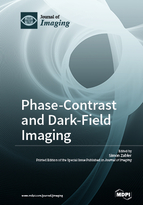Phase-Contrast and Dark-Field Imaging
A special issue of Journal of Imaging (ISSN 2313-433X).
Deadline for manuscript submissions: closed (28 February 2018) | Viewed by 56424
Special Issue Editor
Interests: X-ray imaging; numerical phase retrieval; micro-CT and nano-CT; signal processing; X-ray scattering; materials science; X-ray detectors; X-ray optics; acoustics
Special Issues, Collections and Topics in MDPI journals
Special Issue Information
Dear Colleagues,
Phase-contrast and dark-field imaging have been quickly-growing topics in the field of X-ray imaging for the past 15 years, both in medical and in materials communities. More than one hundred X-ray laboratories, and many synchrotron beamlines, are, today, equipped with Talbot-interferometers, Lau-interferometers or Talbot-Lau setups. However, new setups emerge every day, e.g., based on the far-field moiré effect or on transmission X-ray microscopy. Both grating-based differential phase-contrast and dark-field image contrast have been shown to provide answers to formerly unsolvable questions in the field of medical and material imaging, e.g., imaging human lung tissue at the micrometer level or calculating local fiber orientation in carbon fiber composite automotive parts. Meanwhile, tomographic reconstruction and signal processing for these new contrast modes have become vivid fields of research in mathematics and computer science. Optimizing a grating-interferometer for a given task is not an easy task and requires detailed knowledge, both of the imaging physics and of the signal response from the specimen. Furthermore, the production processes for high-aspect optical gratings are presently at their technological limits, which will have to be overcome using entirely new approaches, if we want use DPC and DIC to inspect larger parts, e.g., from aircrafts and cars.
The intent of this Special Issue is to provide a framework where scientists in several different disciplines, related to phase-contrast and dark-field imaging, can find a place to illustrate their ideas and results.
This Special Issue is primarily focused on the following topics; however, we encourage all submissions related to phase-contrast and dark-field imaging in general:
-
X-ray imaging setups for differential phase-contrast (DPC) and dark-field contrast
-
Data acquisition schemes
-
Signal processing of DPC, DIC and possibly higher orders
-
Volume image reconstruction techniques, in particular non-linear reconstruction
-
Imaging of anisotropic structures (e.g., fibers or tubes)
-
Clinical and pre-clinical results from medical scanners
-
Applications in materials science, biology and geology
-
Novel production processes for high aspect-ratio gratings and apertures
-
Fast and ultra-fast DPC and DIC imaging
-
Comparison between DPC and other phase-contrast methods, e.g., inline p.-c.
-
Comparison between DIC and (ultra-)small angle X-ray scattering data
-
Spectral and coherence properties of X-ray beams for phase-contrast and dark-field imaging
-
Modelling the imaging physics, in particular for dark-field image contrast (DIC)
-
Direct photon-counting detectors for X-ray phase-contrast and dark-field imaging
-
Structured anodes and compact light sources for phase-contrast and dark-field imaging
Guest Editor
Manuscript Submission Information
Manuscripts should be submitted online at www.mdpi.com by registering and logging in to this website. Once you are registered, click here to go to the submission form. Manuscripts can be submitted until the deadline. All submissions that pass pre-check are peer-reviewed. Accepted papers will be published continuously in the journal (as soon as accepted) and will be listed together on the special issue website. Research articles, review articles as well as short communications are invited. For planned papers, a title and short abstract (about 100 words) can be sent to the Editorial Office for announcement on this website.
Submitted manuscripts should not have been published previously, nor be under consideration for publication elsewhere (except conference proceedings papers). All manuscripts are thoroughly refereed through a single-blind peer-review process. A guide for authors and other relevant information for submission of manuscripts is available on the Instructions for Authors page. Journal of Imaging is an international peer-reviewed open access monthly journal published by MDPI.
Please visit the Instructions for Authors page before submitting a manuscript. The Article Processing Charge (APC) for publication in this open access journal is 1800 CHF (Swiss Francs). Submitted papers should be well formatted and use good English. Authors may use MDPI's English editing service prior to publication or during author revisions.
Keywords
- Grating-based phase-contrast
- Talbot-interferometry
- Dark-field image contrast
- X-ray scattering
- X-ray phase-contrast imaging
- Tomographic reconstruction techniques
- Signal processing
- Medical CT
- Industrial CT
- Micro computed tomography
- X-ray detectors
- X-ray optics
- X-ray microscopy
- X-ray tensor tomography







